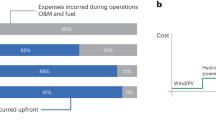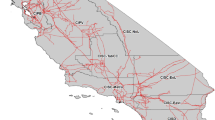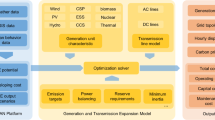Abstract
In many liberalized electricity markets, power generators can receive payments for maintaining capacity through capacity markets. These payments help stabilize generator revenues, making investment in capacity more attractive for risk-averse investors when other outlets for risk trading are limited. Here we develop a heuristic algorithm to solve large-scale stochastic equilibrium models describing a competitive market with incomplete risk trading. Introduction of a capacity mechanism has an asymmetric effect on the risk profile of different generation technologies, tilting the resource mix towards those with lower fixed costs and higher operating costs. One implication of this result is that current market structures may be ill-suited to financing low-carbon resources, the most scalable of which have high fixed costs and near-zero operating costs. Development of new risk trading mechanisms to replace or complement current capacity obligations could lead to more efficient outcomes.
This is a preview of subscription content, access via your institution
Access options
Access Nature and 54 other Nature Portfolio journals
Get Nature+, our best-value online-access subscription
$29.99 / 30 days
cancel any time
Subscribe to this journal
Receive 12 digital issues and online access to articles
$119.00 per year
only $9.92 per issue
Buy this article
- Purchase on Springer Link
- Instant access to full article PDF
Prices may be subject to local taxes which are calculated during checkout

Similar content being viewed by others
Data availability
The code and data used for numerical tests in this study are available in a public repository (https://doi.org/10.5281/zenodo.3242844).
References
Bushnell, J., Flagg, M. & Mansur, E. Capacity Markets at a Crossroads Working Paper 278 (Energy Institute at Haas, 2017).
Oren, S. S. Generation adequacy via call options obligations: safe passage to the promised land. Electricity J. 18, 28–42 (2005).
Joskow, P. in The New Energy Paradigm (ed. Helm, D.) Ch. 4 (Oxford Univ. Press, 2007).
Cramton, P. & Stoft, S. The Convergence of Market Designs for Adequate Generating Capacity with Special Attention to the CAISO's Resource Adequacy Problem (MIT Center for Energy and Environmental Policy Research, 2006); https://dspace.mit.edu/handle/1721.1/45053
Hogan, W. W. Electricity scarcity pricing through operating reserves. Econ. Energy Environ. Policy 2, 65–86 (2013).
Joskow, P. & Tirole, J. Reliability and competitive electricity markets. RAND J. Econ. 38, 60–84 (2007).
Cramton, P., Ockenfels, A. & Stoft, S. Capacity market fundamentals. Econ. Energy Environ. Policy 2, 27–46 (2013).
Bothwell, C. & Hobbs, B. F. Crediting wind and solar renewables in electricity capacity markets: the effects of alternative definitions upon market efficiency. Energy J. 38(SI), 173–188 (2017).
Ehrenmann, A. & Smeers, Y. Generation capacity expansion in a risky environment: a stochastic equilibrium analysis. Oper. Res. 59, 1332–1346 (2011).
Vazquez, C., Rivier, M. & Perez-Arriaga, I. J. A market approach to long-term security of supply. IEEE Trans. Power Syst. 17, 349–357 (2002).
Neuhoff, K. & De Vries, L. Insufficient incentives for investment in electricity generations. Util. Policy 12, 253–267 (2004).
Schiro, D. A., Hobbs, B. F. & Pang, J. S. Perfectly competitive capacity expansion games with risk-averse participants. Comput. Optim. Appl. 65, 511–539 (2016).
Roques, F. A., Nuttall, W. J., Newberry, D. M., de Neufville, R. & Connors, S. Nuclear power: a hedge against uncertain gas and carbon prices? Energy J. 27, 1–24 (2006).
Roques, F. A., Newbery, D. M. & Nuttall, W. J. Fuel mix diversification incentives in liberalized electricity markets: a mean–variance portfolio theory approach. Energy Econ. 30, 1831–1849 (2008).
Gross, R., Blyth, W. & Heptonstall, P. Risks, revenues and investment in electricity generation: why policy needs to look beyond costs. Energy Econ. 32, 796–804 (2010).
Guo, X., Beskos, A. & Siddiqui, A. The natural hedge of a gas-fired power plant. Comput. Manag. Sci. 13, 63–86 (2016).
Ehrenmann, A. & Smeers, Y. in Stochastic Optimization Methods in Finance and Energy: New Financial Products and Energy Market Strategies (eds. Bertocchi, M., Consigli, G. & Dempster, M. A. H.) 273–310 (Springer, 2011).
Philpott, A., Ferris, M. & Wets, R. Equilibrium, uncertainty and risk in hydrothermal electricity systems. Math. Program. 157, 483–513 (2016).
Ferris, M. & Philpott, A. Dynamic Risked Equilibrium (2018); www.optimization-online.org/DB_HTML/2018/04/6577.html
Ralph, D. & Smeers, Y. Risk trading and endogenous probabilities in investment equilibria. SIAM J. Optim. 25, 2589–2611 (2015).
Newbery, D. Missing money and missing markets: reliability, capacity auctions and interconnectors. Energy Policy 94, 401–410 (2016).
O’Shaughnessy, E., Heeter, J. & Sauer, J. Status and Trends in the US Voluntary Green Power Market (2017 Data) (National Renewable Energy Laboratory, 2018); www.nrel.gov/docs/fy19osti/72204.pdf
Joskow, P. Capacity payments in imperfect electricity markets: need and design. Util. Policy 16, 159–170 (2008).
Cheng, I. H. & Xiong, W. Financialization of commodity markets. Annu. Rev. Financ. Econ. 6, 419–441 (2014).
Hirshleifer, D. Hedging pressure and futures price movements in a general equilibrium model. Econometrica 58, 411–428 (1990).
Resource Investment in Competitive Markets (PJM Interconnection, 2016); www.pjm.com//media/library/reports-notices/special-reports/20160505-resource-investment-in-competitive-markets-paper.ashx
Pierpont, B. & Nelson, D. Markets for Low Carbon, Low Cost Electricity Systems (Climate Policy Initiative, 2017); https://climatepolicyinitiative.org/publication/markets-low-carbon-low-cost-electricity-systems-working-paper
Gimon, E. On Market Designs for a Future with a High Penetration of Variable Renewable Generation (Energy Innovation LLC, 2017); https://americaspowerplan.com/wp-content/uploads/2017/10/On-Market-Designs-for-a-Future-with-a-High-Penetration-of-Renew.pdf
Macdonald, B. & Du, M. Project Finance Industry Report Card (S&P Global Ratings, 2017); https://www.spratings.com/documents/20184/1634005/SPGR_Project+Finance+Industry+Report+Card-052217/1a91054b-709b-49cb-9473-3f0f3affbc2a
Butler, L. & Neuhoff, K. Comparison of feed-in tariff, quota and auction mechanisms to support wind power development. Renew. Energy 33, 1854–1867 (2008).
Polzin, F., Egli, F., Steffen, B. & Schmidt, T. S. How do policies mobilize private finance for renewable energy? A systematic review with an investor perspective. Appl. Energy 236, 1249–1268 (2019).
Levin, T. & Botterud, A. Electricity market design for generator revenue sufficiency with increased variable generation. Energy Policy 87, 392–406 (2015).
Frew, B. A. et al. Revenue Sufficiency and Reliability in a Zero Marginal Cost Future (National Renewable Energy Laboratory, 2016); www.nrel.gov/docs/fy17osti/66935.pdf
Milligan, M. et al. Wholesale electricity market design with increasing levels of renewable generation: revenue sufficiency and long-term reliability. Electricity J. 29, 26–38 (2016).
Joskow, P. L. Challenges for wholesale electricity markets with intermittent renewable generation at scale: the US experience. Oxf. Rev. Economic Policy 35, 291–331 (2019).
Artzner, P., Delbaen, F., Eber, J. M. & Heath, D. Coherent measures of risk. Math. Finance 9, 203–228 (1999).
Rockafellar, R. T. & Uryasev, S. Optimization of conditional value-at-risk. J. Risk 2, 21–41 (2000).
Strengthening Reliability: An Analysis of Capacity Performance (PJM Interconnection, 2018); https://www.pjm.com/-/media/library/reports-notices/capacity-performance/20180620-capacity-performance-analysis.ashx (2018).
de Maere d’Aertrycke, G., Ehrenmann, A. & Smeers, Y. Investment with incomplete markets for risk: the need for long-term contracts. Energy Policy 105, 571–583 (2017).
Renewable Energy Certificates Annex to the EEI Master Power Purchase and Sale Agreement (Edison Electric Institute, 2010); www.eei.org/resourcesandmedia/mastercontract/Documents/EEI%20RECs%20Annex%20v1.pdf
D’Aertrycke, G., Ehrenmann, A., Ralph, D. & Smeers, Y. Risk Trading in Capacity Equilibrium Models Cambridge Working Paper Economics: 1757 (University of Cambridge, 2017).
Abada, I., de Maere d’Aertrycke, G. & Smeers, Y. On the multiplicity of solutions in generation capacity investment models with incomplete markets: a risk-averse stochastic equilibrium approach. Math. Program. 165, 5–69 (2017).
Britz, W., Ferris, M. & Kuhn, A. Modeling water allocating institutions based on multiple optimization problems with equilibrium constraints. Environ. Model. Softw. 46, 196–207 (2013).
Ferris, M. C. & Munson, T. S. Complementarity problems in GAMS and the PATH solver. J. Economic Dyn. Control 24, 165–188 (2000).
Höschle, H., Le Cadre, H., Smeers, Y., Papavasiliou, A. & Belmans, R. An ADMM-based method for computing risk-averse equilibrium in capacity markets. IEEE Trans. Power Syst. 33, 4819–4830 (2018).
Fourer, R., Gay, D. M. & Kernighan, B. W. in Algorithms and Model Formulations in Mathematical Programming (eds. Wallace, S. W.) 150–151 (Springer, 1989).
IBM ILOG CPLEX optimizer (IBM, 2015).
Schwele, A., Kazempour, J. & Pinson, P. Do unit commitment constraints affect generation expansion planning? A scalable stochastic model. Energy Syst. https://doi.org/10.1007/s12667-018-00321-z (2019).
Glowinski, R. & Marroco, A. Sur l’approximation, par éléments finis d’ordre un, et la résolution, par pénalisation-dualité d’une classe de problèmes de Dirichlet non linéaires. ESAIM: Math. Model. Num. 9, 41–76 (1975).
Gabay, D. & Mercier, B. A dual algorithm for the solution of nonlinear variational problems via finite element approximation. Computers Math. Appl. 2, 17–40 (1976).
Gérard, H., Leclère, V. & Philpott, A. On risk averse competitive equilibrium. Oper. Res. Lett. 46, 19–26 (2018).
Acknowledgements
This research was supported, in part, by Northwestern University’s Center for Optimization and Statistical Learning. The views expressed in this article are not necessarily those of the Federal Energy Regulatory Commission.
Author information
Authors and Affiliations
Contributions
J.M. planned and performed the analysis. D.P.M. reviewed the manuscript, in particular with reference to the models and algorithm. R.P.O. reviewed the manuscript, in particular with reference to the electricity market design.
Corresponding author
Ethics declarations
Competing interests
The authors declare no competing interests.
Additional information
Publisher’s note Springer Nature remains neutral with regard to jurisdictional claims in published maps and institutional affiliations.
Supplementary information
Supplementary Information
Supplementary notes 1–5, Tables 1 and 2 and refs. 1–8.
Rights and permissions
About this article
Cite this article
Mays, J., Morton, D.P. & O’Neill, R.P. Asymmetric risk and fuel neutrality in electricity capacity markets. Nat Energy 4, 948–956 (2019). https://doi.org/10.1038/s41560-019-0476-1
Received:
Accepted:
Published:
Issue Date:
DOI: https://doi.org/10.1038/s41560-019-0476-1
This article is cited by
-
A Mean Field Game Model for Renewable Investment Under Long-Term Uncertainty and Risk Aversion
Dynamic Games and Applications (2024)
-
Coordination of power and natural gas markets via financial instruments
Computational Management Science (2021)
-
Risky being green
Nature Energy (2019)



